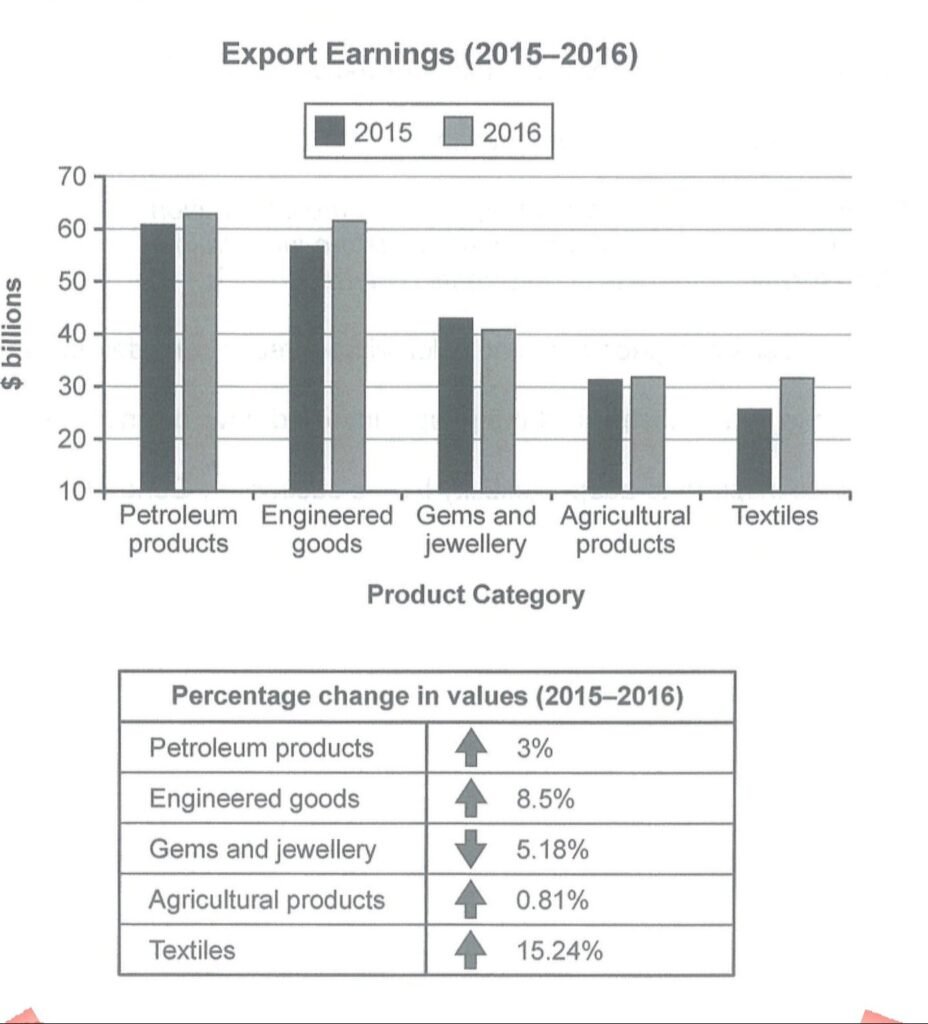Writing Task 1
You should spend about 20 minutes on this task.
The chart below shows the value of one country’s exports in various categories during 2015 and 2016. The table shows the percentage change in each category of exports in 2016 compared with 2015.
Summarise the information by selecting and reporting the main features, and make comparisons where relevant.
Write at least 150 words.

Writing Task 2
You should spend about 40 minutes on this task.
Write about the following topic:
Some people say that the main environmental problem of our time is the loss of particular species of plants and animals. Others say that there are more important environmental problems.
Discuss both views and give your own opinion.
Give reasons for your answer and include any relevant examples from your own knowledge or experience.
Write at least 250 words.
Cambridge IELTS 14 Academic Writing Test 2 Task 1 Model Answer (217 words)
The bar chart illustrates the export earnings of a country across five different categories—Petroleum products, Engineered goods, Gems and jewellery, Agricultural products, and Textiles—for the years 2015 and 2016. The table below the chart provides the percentage change in export values for each category between these two years.
Overall, most categories experienced growth in export earnings from 2015 to 2016, with textiles showing the largest percentage increase, while agricultural products had the smallest growth.
Petroleum products, which accounted for the highest earnings in both years, saw a moderate increase of 3%, rising from just under $60 billion in 2015 to around $62 billion in 2016. Engineered goods also showed significant growth, with an 8.5% increase, going from about $55 billion in 2015 to over $60 billion in 2016. Gems and jewellery experienced a 5.18% rise, though their export earnings remained below $50 billion in both years.
Agricultural products, while growing slightly by 0.81%, saw export values stay relatively constant at around $30 billion. In contrast, textiles experienced the largest percentage growth (15.24%), rising from around $25 billion in 2015 to approximately $32 billion in 2016.
In summary, while all categories showed positive growth, textiles and engineered goods had the most notable increases in percentage terms, and petroleum products remained the largest contributor to export earnings.
Cambridge IELTS 14 Academic Writing Test 2 Task 2 Model Answer (365 words)
Some people consider that the loss of individual species of plants and animals is the main environmental problem of our time. Attempts to preserve rare or dying species are carried out in zoos or other specialist plant and animal facilities, through breeding programmes, preservation orders and other forms of protection and there was genuine sadness among many when the last surviving white rhino died earlier this year.
Survival of the fittest is nature’s way of ruthlessly allowing weaker specimens to die out, although mankind has also contributed to falling animal numbers through hunting and poaching. However, whether saving individual species should be the main focus of environmental protection is debatable. Climate change and excessive use of plastic are just two other major problems that deserve our attention.
The evidence of climate change is there for us all to see: rising sea levels and associated flooding with the loss of homes at low land levels are becoming more frequent. Many countries and island communities are now calling for urgent action to delay, halt or even reverse the process, although if we believe the experts, reversal is impossible. Habitable able areas are gradually shrinking, often for some of the poorest groups of people, but seems to be little obvious action taking place. If the major contributors to climate change will not support the reduction of greenhouse gases, there is little hope for the future.
Naturalists have also begun to expose the serious problems arising from discarded plastic waste. Birds and animals can die gruesome deaths through being trapped or caught up in plastic bags or ropes, while the long process required for these plastics to decay means that they remain a threat for many years to come. Worse, there is now beginning to be evidence of sea creatures ingesting smaller globules of disintegrating plastic, which harms them and all the other creatures in their particular food chain.
The loss of particular species, both flora and fauna, is cause for regret, but I do not agree that they are the most important environmental problems these days. If climate change and damage from plastic continue, there will be less land and less food for everyone, including plants and animals.
Leave a Reply